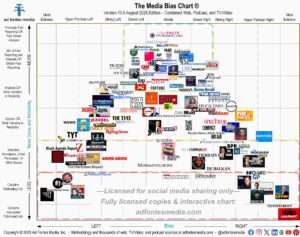
EV Intenders Consume High Quality News
Author:
Brad Berens
Date:
07/26/2023
Advertisers promoting electric cars should pay attention to High Quality News, because the people who consume it are more likely to be shopping for an EV than folks who consume other media—including the Super Bowl!
Our recent Advertising Value of High Quality News report, conducted with our friends at CivicScience, painted a picture of the folks who consume that news and why they are attractive for advertisers.
When we say, “High Quality News,” we’re talking about the highly reliable and unbiased sources in the green box on our famous Media Bias Chart®. “Low Quality News” refers to the unreliable and biased sources in the orange and red boxes on the chart.
In my last post, I shared general findings: High Quality News consumers are healthier, better educated, and have more disposable income than their counterparts who consume Low Quality News.
This time, let’s dig into one group: people who are in-market for Electric Vehicles or “EV Intenders.”
Larger percentages of High Quality News consumers are EV Intenders than: Low Quality News consumers, the baseline of U.S. adults, and even folks who watch the Super Bowl.
This means advertisers should pay attention to opportunities to place their ads in High Quality News because their best future customers are there, and the inventory is priced to sell.
Car buyers are leaning into EVs, and all the major auto manufacturers are pivoting into increased EV production as governments around the world slowly phase out new gas-powered cars. For example, Californians will buy their last gas cars in 2034.
Tesla, the most popular EV by a wide margin, historically did not advertise at all until it decided to dip a cautious toe into advertising in May.
That means that advertisers representing competitor EV brands have an almost clear field to build EV Intender awareness of new electric cars coming from established auto manufacturers like Ford, GM, Nissan, and Toyota, as well as newer, native EV brands like Faraday Future, Lucid, Polestar, and Rivian.
These advertisers will find their ideal future buyers consuming High Quality News.
Online
Folks who consume High Quality News online are five percent more likely to be EV Intenders than consumers of Low Quality News.
The online High Quality News folks are nine percent more likely to be EV Intenders than people who watch the Super Bowl.
They are also 14% more likely to be EV Intenders than the baseline of U.S. adults. This last number is important because it shows that High Quality News is more effective for advertisers trying to reach EV Intenders than general web content.
Television
Here, the differences between High Quality and Low Quality News consumers are more striking: folks who consume High Quality News on television are 51% more likely to be EV Intenders than their counterparts!
The consumers of television High Quality News are also 10% more likely to be EV Intenders than the baseline of U.S. adults, which means that EV advertisers looking for their best future customers will find more of them watching “CBS Evening News with Norah O’Donnell” or ABC’s “Good Morning America” than “Young Sheldon” or “The Price Is Right.”
Television High Quality News consumers are also three percent more likely to be EV Intenders than Super Bowl viewers. That’s a tiny difference, and possibly within the margin of error, but when it comes to Return on Advertising Spend (ROAS) the $7 Million cost of one 30 second ad in the big game might pay for months of running that same ad in High Quality News.
Advertising in High Quality News isn’t just the right thing to do, it’s also the smart thing to do.
You can learn more in the full report. Stay tuned for more research coming soon.


